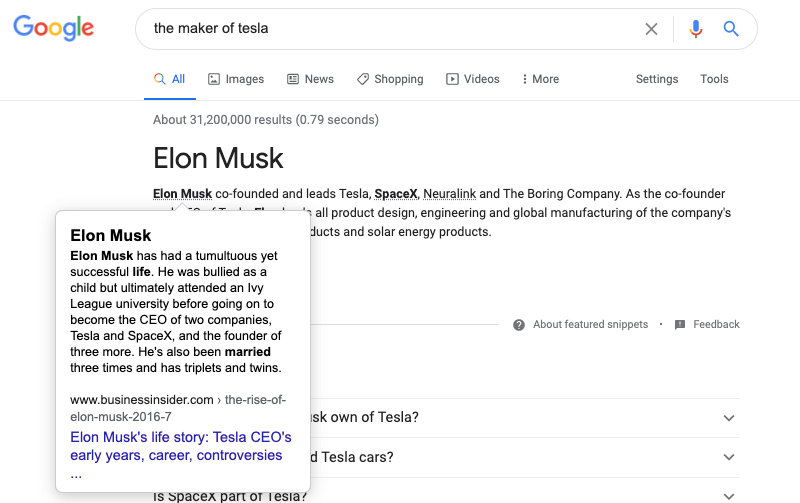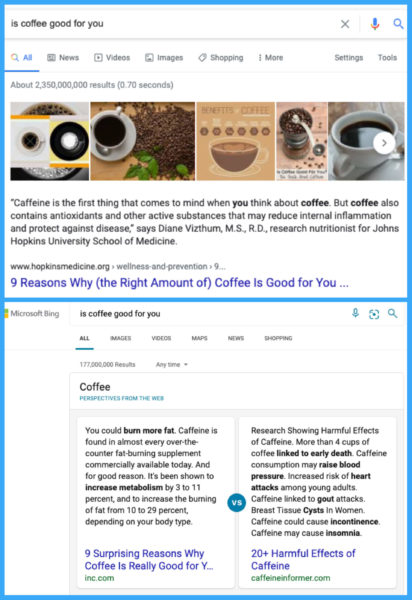Contextual links in featured snippets may present new opportunities and risks
The change has SEOs questioning which sites will win and which will lose, but one thing is certain: Nobody is going to stop optimizing for featured snippets.
In November, contextual links began appearing in Google’s featured snippets. Although it’s still in the testing phase, the potential for more links to appear in this high-visibility search result feature has SEOs concerned about what that may mean for their click-through rates, the safety of their brands as well as how they might optimize for it.
The potential implications of contextual links in featured snippets
“What could put some publishers off is the fact that winning a featured snippet may now result in sharing the spoils with the other websites that were linked to,” said Izzi Smith, technical SEO analyst at Ryte, adding that the stakes can get higher if links to competing sites also appear.
Instead of being strictly worse for publishers, this may actually be more of a double-edged sword. If other sites can get linked to in your featured snippets, you may also be able to seize that opportunity as well. “My reach would be expanded by my featured snippets being referenced in other featured snippets, so it’s likely a win overall even though I may lose a few clicks on the single snippet,” said Patrick Stox, technical SEO and product advisor at Ahrefs, who suspects that Google is referencing other featured snippets in its contextual links.
Although this new aspect of featured snippets carries a range of implications, it is unlikely to prevent publishers from pursuing them. “In the current form, I don’t believe it will change much,” said Melbourne-based SEO consultant Brodie Clark, who first brought this feature to our attention. This sentiment was echoed by the majority of professionals who spoke to us for this article.
Third-party sites stand to gain, but perhaps not all, and not risk-free
“These are likely to be a big win for reference sites like dictionary.com and Wikipedia, as well as sites which have taken the time to create knowledge resources for users,” said Crystal Carter, senior digital strategist at Optix Solutions. “Because of the definition-styled links, it’s only sites similar to Wikipedia that will appear for the most part, which is an extremely small portion of sites on the web,” Clark said in agreement.

The majority of contextual links do seem to cite the aforementioned informational sources, but there are exceptions, such as the Business Insider link in the example below.

Limiting contextual links to informational sites and journalistic publications may prevent featured snippets from becoming a battleground within the greater arena of the search results page. However, that is likely to limit the links Google can present.
“I actually think this will become a new targeting tactic for third-party sites as they see an increase in their traffic,” said Jori Ford, CMO at Food Boss, should contextual links be available to all publishers. One theory floated by multiple professionals is that the contextual links point to other content that earned a featured snippet. If that is the case, “I’d suspect those who own snippets for broader queries will see an uptick,” Ford said.
Appearing as a contextual link may not always be advantageous, though. “This update would take away the control website owners have in relation to where their content appears, and which brands they are then potentially associated with,” Tom Crewe, head of SEO at Adido, told Search Engine Land. “If the topic is of negative sentiment or something completely unrelated, there might be a connection made that isn’t desirable for the third-party source,” Smith added.
More to consider when optimizing for featured snippets
While featured snippets remain the object of desire, this change could add a new layer to consider when optimizing for them. “One way in which my strategy might adapt is to start identifying where contextual links are appearing within my own featured snippets, and creating content that caters to those contextual links,” Crewe said. At this point, this strategy is still impossible to test, but if it works, it could help remove links to other sites and replace them with links to your own content.
Some publishers may take the opposite approach and follow Google’s lead. “If rolled out, I’m fully confident that adding outgoing links to your content will become a part of every featured snippet-winning strategy,” Smith said, reasoning that many SEOs already emulate existing featured snippet formatting (paragraphs, tables and lists) in hopes of winning them. “Perhaps if connections to sources are a defining factor, websites that already do this will stand to gain initially (especially for higher YMYL websites that already need to provide expert references and fact sources),” Smith added.
SEOs see room for improvement
If this change becomes a permanent aspect of featured snippets, one thing is certain: SEOs want more, clearly defined data and more control.
“Reporting on contextual links within Search Console would be a huge help, as it would give publishers an indication of how this impacts their CTR,” Crewe said, adding that this data would also help to identify topics that publishers could provide more detail on so that they can potentially keep the contextual link on their own sites.
“A snippet tag that can support if publishers don’t want alternate source data included should be a consideration,” Ford suggested. Alternatively, the ability to opt-out of appearing as a contextual link may help alleviate brand safety concerns.
It’s good for users, but who else is it good for?
It is not uncommon for Google to tout changes and updates as being good for users, while being more tight-lipped about how much the company itself also benefits or how any given change may negatively impact businesses and publishers. Contextual links in featured snippets, however, may be more of a mixed bag than first impressions would lead us to believe.
Clearly, more context is better for users, but this can also diminish the need for users to conduct another search, “which I guess works against Google if they can’t service another set of ads,” Clark pointed out, caveating that many of these broad queries may not have relevant ads.
More sites appearing on a featured snippet that was once owned by a single publisher can be problematic, but “it could be a positive step towards reducing the online ‘echo chamber’ and broadening the horizons of users across the web,” Crewe said. This would likely be an unintended benefit, as Google seems to favor providing users with one simple, direct answer.

“Alternatively, this could simply be a way of Google mitigating the incoming accusations from publishers who claim that featured snippets only benefit Google and not the content creator,” Smith said, “By providing deep links to more articles within the entire feature, it could stand to benefit a greater amount of content providers.” Appeasing publishers, and regulators, has become a larger hurdle for the company in recent years. This week, however, it stated that it would rather turn off its search service in Australia than pay to link to sites.
Contributing authors are invited to create content for Search Engine Land and are chosen for their expertise and contribution to the search community. Our contributors work under the oversight of the editorial staff and contributions are checked for quality and relevance to our readers. The opinions they express are their own.
Related stories